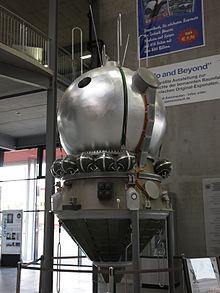
The Buran programme, also known as the "VKK Space Orbiter programme", was a Soviet and later Russian reusable spacecraft project that began in 1974 at the Central Aerohydrodynamic Institute in Moscow and was formally suspended in 1993. In addition to being the designation for the whole Soviet/Russian reusable spacecraft project, Buran was also the name given to orbiter 1K, which completed one uncrewed spaceflight in 1988 and was the only Soviet reusable spacecraft to be launched into space. The Buran-class orbiters used the expendable Energia rocket as a launch vehicle.

Soyuz is a series of spacecraft which has been in service since the 1960s, having made more than 140 flights. It was designed for the Soviet space program by the Korolev Design Bureau. The Soyuz succeeded the Voskhod spacecraft and was originally built as part of the Soviet crewed lunar programs. It is launched on a Soyuz rocket from the Baikonur Cosmodrome in Kazakhstan. Between the 2011 retirement of the Space Shuttle and the 2020 demo flight of SpaceX Crew Dragon, the Soyuz served as the only means to ferry crew to or from the International Space Station, for which it remains heavily used. Although China did launch crewed Shenzhou flights during this time, none of them docked with the ISS.

The R-7 Semyorka, officially the GRAU index 8K71, was a Soviet missile developed during the Cold War, and the world's first intercontinental ballistic missile. The R-7 made 28 launches between 1957 and 1961. A derivative, the R-7A, was operational from 1960 to 1968. To the West it was unknown until its launch. In modified form, it launched Sputnik 1, the first artificial satellite, into orbit, and became the basis for the R-7 family which includes Sputnik, Luna, Molniya, Vostok, and Voskhod space launchers, as well as later Soyuz variants. Various modifications are still in use and it has become the world’s most reliable space launcher.

Voskhod 1 was the seventh crewed Soviet space flight. Flown by cosmonauts Vladimir Komarov, Konstantin Feoktistov, and Boris Yegorov, it launched 12 October 1964, and returned on the 13th. Voskhod 1 was the first human spaceflight to carry more than one crewman into orbit, the first flight without the use of spacesuits, and the first to carry either an engineer or a physician into outer space. It also set a crewed spacecraft altitude record of 336 km (209 mi).
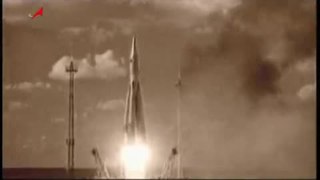
The Soviet space program was the national space program of the Union of Soviet Socialist Republics (USSR), active from 1955 until the dissolution of the Soviet Union in 1991.
Korabl-Sputnik 3 or Vostok-1K No.3, also known as Sputnik 6 in the West, was a Soviet spacecraft which was launched in 1960. It was a test flight of the Vostok spacecraft, carrying two dogs; Pcholka and Mushka, as well as a television camera and scientific instruments.
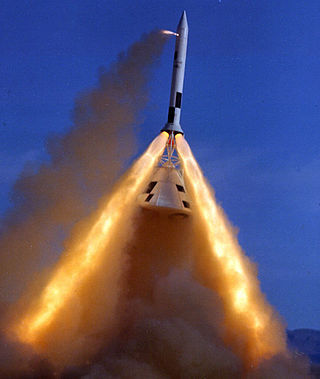
A launch escape system (LES) or launch abort system (LAS) is a crew-safety system connected to a space capsule. It is used in the event of a critical emergency to quickly separate the capsule from its launch vehicle in case of an emergency requiring the abort of the launch, such as an impending explosion. The LES is typically controlled by a combination of automatic rocket failure detection, and a manual activation for the crew commander's use. The LES may be used while the launch vehicle is still on the launch pad, or during its ascent. Such systems are usually of three types:
Tonka is the name given to a German-designed rocket propellant first used in the Wasserfall missile, and recently used by North Korea. It was used in the Soviet Union under the name TG-02, for example in the engine designs of the A.M. Isayev Chemical Engineering Design Bureau.

The Bereznyak-Isayev BI-1 was a Soviet short-range rocket-powered interceptor developed during the Second World War.
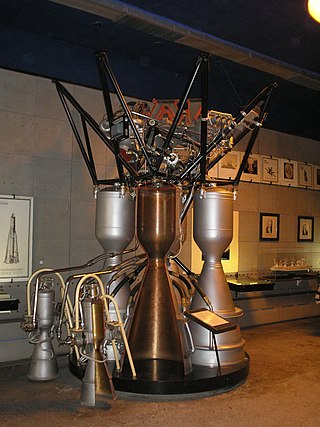
The RD-107 and its sibling, the RD-108, are a type of rocket engine initially used to launch R-7 Semyorka missiles. RD-107 engines were later used on space launch vehicles based on the R-7. As of 2021, very similar RD-107A and RD-108A engines are used to launch the Soyuz-2.1a, and Soyuz-2.1b, which are in active service.
The S5.98M, also known as the 14D30, is a Russian rocket engine, currently powering the Briz upper stages. It was designed by KB KhIMMASH, the famous Isaev designed bureau, and it burns UDMH and N2O4 in a gas-generator cycle.
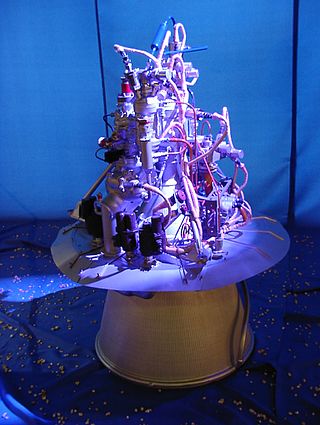
The RD-0109 is a rocket engine burning liquid oxygen and kerosene in a gas generator combustion cycle. It has single nozzle and is an evolution of the RD-0105. It was the engine used on the Vostok Block-E that launched Yuri Gagarin to orbit.
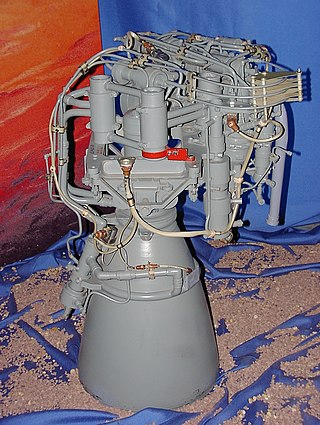
The S5.92 is a Russian rocket engine, currently used on the Fregat upper stage.
The KTDU-35 was a Soviet spacecraft propulsion system composed of two liquid rocket engines, the primary, S5.60 (SKD) and the secondary S5.35 (DKD), fed from the same propellant tanks. Both engines burn UDMH and AK27I in the gas generator cycle. It was designed by OKB-2, the famous Isaev Design Bureau, for the original Soyuz programme.

The KTDU-80 (Russian: Корректирующе-Тормозная Двигательная Установка, КТДУ) is the latest of a family of integrated propulsion system that KB KhIMMASH has implemented for the Soyuz since the Soyuz-T. It integrates main propulsion, RCS and attitude control in a single system pressure fed from a common dual string redundant pressurized propellant system. The common propellant is UDMH and N2O4 and the main propulsion unit, is the S5.80 main engine. It generates 2.95 kN (660 lbf) of thrust with a chamber pressure of 880 kPa (128 psi) and a nozzle expansion of 153.8 that enables it to achieve a specific impulse of 302 s (2.96 km/s). It is rated for 30 starts with a total firing time of 890 seconds. The integrated system without the pressurization or tanks weighs 310 kg (680 lb); it is 1.2 m (47 in) long with a diameter of 2.1 m (83 in).
The S5.80 is a liquid pressure-fed rocket engine burning N2O4/UDMH with an O/F of 1.85. It is used for crew-rated spacecraft propulsion applications. It is currently used in the Soyuz-TMA-M spacecraft propulsion module KTDU-80, and its sibling, the S5.79 rocket engine, is still used as the main propulsion of the Zvezda ISS module. The S5.80 generates 2.95 kN (660 lbf) of thrust with a chamber pressure of 0.88 MPa (128 psi) and a nozzle expansion of 153.8 that enables it to achieve a specific impulse of 302 s (2.96 km/s). It is rated for 30 starts with a total firing time of 890 seconds. The engine, without the pressurization system or propellant tanks, weighs 310 kg (680 lb) and is an integrated unit that is 1.2 m (47 in) long with a diameter of 2.1 m (83 in).
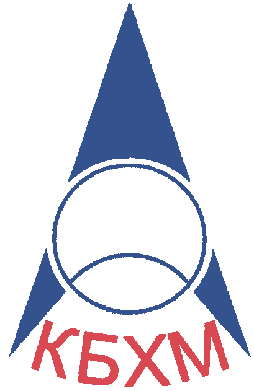
The A.M. Isayev Chemical Engineering Design Bureau, also known as KB KhimMash or just KBKhM, is a Russian rocket engine design and manufacturing company. It is located in the city of Korolyov. It started as the OKB-2 division of the NII-88 research institute, where A.Isaev directed the development of liquid rocket engines for ballistic missile submarines.
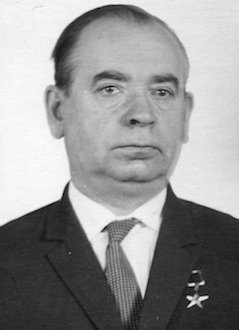
Leonid Alexandrovich Voskresensky was a Soviet engineer in the Soviet space program, and long-time associate of Chief Designer Sergei Korolev. He served as launch director for Sputnik and for the first crewed space flight, Vostok 1. The lunar crater Voskresenskiy is named in his honor.
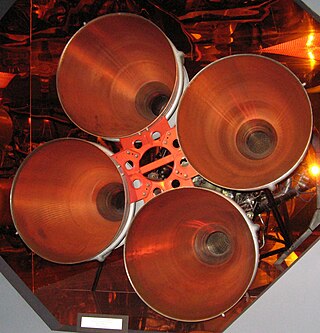
Soviet rocketry commenced in 1921 with development of Solid-fuel rockets, which resulted in the development of the Katyusha rocket launcher. Rocket scientists and engineers, particularly Valentin Glushko and Sergei Korolev, contributed to the development of Liquid-fuel rockets, which were first used for fighter aircraft. Developments continued in the late 1940s and 1950s with a variety of ballistic missiles and ICBMs, and later for space exploration which resulted in the launch of Sputnik 1 in 1957, the first artificial Earth satellite ever launched.
